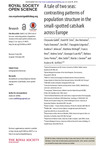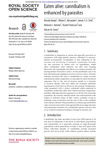Search
Now showing items 11-20 of 67
Seasonal changes in the altitudinal distribution of nocturnallymigrating birds during autumnmigration
(2015)
Wind plays a significant role in the flight altitudes selected by nocturnally migrating birds. At mid-latitudes in the Northern Hemisphere, atmospheric conditions are dictated by the polar-front jet stream, whose amplitude ...
Phenotypic assortment in wild primate networks
(2015)
Individuals’ access to social information can depend on their social network. Homophily—a preference to associate with similar phenotypes—may cause assortment within social networks that could preclude information transfer ...
Assessing costs of carrying geolocators using feather corticosterone in two species of aerial insectivore
(2015)
Despite benefits of using light-sensitive geolocators to track animal movements and describe patterns of migratory connectivity, concerns have been raised about negative effects of these devices, particularly in small ...
New evidence on the tool assisted hunting exhibited by chimpanzees
(2015)
For anthropologists, meat eating by primates like chimpanzees (Pan troglodytes) warrants examination given the emphasis on hunting in human evolutionary history. As referential models, apes provide insight into the evolution ...
Ataleoftwo seas: contrasting patterns of population structure in the small-spotted catshark across Europe
(The Royal Society, 2014)
Elasmobranchs represent important components of marine ecosystems, but they can be vulnerable to overexploitation. This has driven investigations into the population genetic structure of large-bodied pelagic sharks, but ...
Competition and cooperationina synchronous bushcricket chorus
(The Royal Society, 2014)
Synchronous signalling within choruses of the same species either emerges from cooperation or competition. In our study on the katydid Mecopoda elongata, we aim to identify mechanisms driving evolution towards synchrony. ...
High atmospheric temperatures and ‘ambient incubation’ drive embryonic development and lead to earlier hatching in a passerine bird
(The Royal Society, 2016)
Tropical and subtropical species typically experience relatively high atmospheric temperatures during reproduction, and are subject to climate-related challenges that are largely unexplored, relative to more extensive work ...
Males migrate farther than females in a differential migrant: an examination of the fasting endurance hypothesis
(The Royal Society, 2014)
Patterns of migration including connectivity between breeding and non-breeding populations and intraspecific variation in the distance travelled are important to study because they can affect individual fitness and population ...
Eaten alive: cannibalism is enhanced by parasites
(The Royal Society, 2015)
Cannibalism is ubiquitous in nature and especially pervasive in consumers with stage-specific resource utilization in resource-limited environments. Cannibalism is thus influential in the structure and functioning of ...
Carry over bodymass effect from winter to breeding in a resident seabird, the little penguin
(The Royal Society, 2015)
Using body mass and breeding data of individual penguins collected continuously over 7 years (2002–2008), we examined carry-over effects of winter body mass on timing of laying and breeding success in a resident seabird, ...










